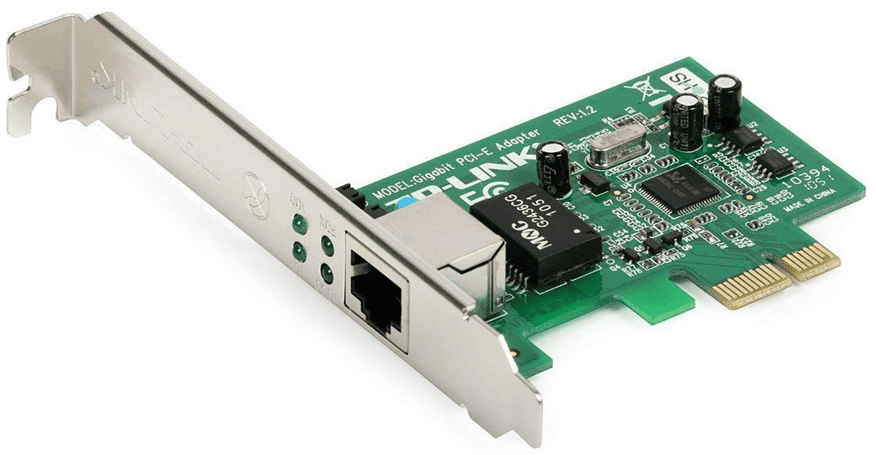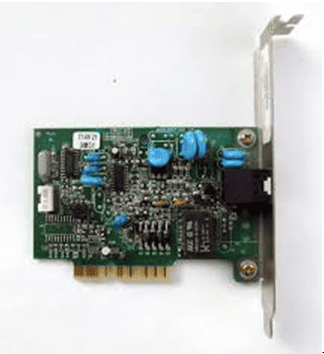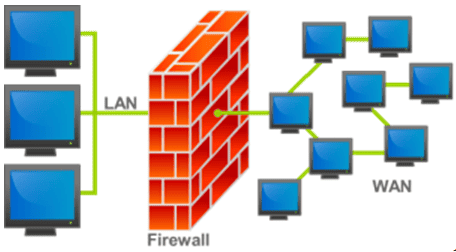Welcome to CertBlaster ExamNotes! We will look at 220-1001 Sub-objective 2.2 Compare and contrast common networking hardware devices. We will look at the evolution of interconnectivity and the roles these devices play.

Hub
The smallest network you can create is a one-to-one (Peer to Peer) relationship between two computers or devices. A hub is designed to distribute multiple signals to multiple hosts. Communications are managed by CSMA (Carrier Sense –Multiple Access), where the host will check the cable to see if it is clear before transmission is initiated. When a signal is distributed by a hub, it is sent to all connected devices, causing a burst of communications if left unchecked.
Devices connect to hubs and switches either wirelessly or through RJ-45 UTP cabling. The wired connection requires a Network interface card (NIC) as shown below.

PCI Express 1X Ethernet card.
A switch determines whether or not a destination Hardware (MAC) or network (IP) address is attached to the switch itself. A switch uses MAC or IP addressing knowledge about the devices connected to it and the device oriented environment it exists in. Switches utilize packet switching and the information contained in each packet to determine if the destination for the packet is connected locally or needs to be forwarded upstream. Unlike a hub, an unmanaged switch uses the information gained to direct traffic to the correct port. Switches operate as MAC Bridges.
The goal of a switch is to enable efficient traffic management. A managed switch has features not found in an unmanaged switch such as VLAN support and traffic prioritization. Managed switches can use the SNMP protocol to enable remote management.
Cable management is always important. It is especially important when there are a large number of users assigned and the cable closet is not particularly roomy. The purpose of a patch panel is to connect and manage inbound and outbound cables in a central area. Typically, the destination would be labeled on the panel and lead to a wall jack. Presented below is a good example of a well-organized patch panel. Take a good look. Notice the really precise cable routing and management of four switches in a well-kept server space. Most installations start out like this.

Patch Panel
Here they all are rolled into one device! Most reputable ISPs provide a device like the one shown. For this image, we took the most fully featured non-ISP related modem available. My guess is that most of you have seen a variation of this in your travels. This device is a Cable Modem, Router, Firewall and Wireless Access Point as well as a Switch/Bridge.

Wireless router
Think of the Router as your network traffic cop. Ultimately, the router and the firewall which has the final say, decides which traffic does and does not get on to your network. The router is useful for finding the quickest path for your data to take while finding its way through the maze of routers and servers from point to point. Shown here is a combination Router/ Wireless Access Point. It is responsible for routing and also access to the Wireless Network among other functions.
Cloud resources and even entire virtual networks can be accessible using Software Defined Networking (SDN). Network management can be delegated to cloud resources to provide centralized management. This technique can be used to create virtual WANs.
Here is a diagram explaining the function of a bridge. The bridge takes the digital signal from the Wireless environment and converts it for use with a wired entertainment component.

Bridge diagram
When one thinks of a modem, one thinks of the traditional digital to analog phone modem, where the signal is converted from digital to analog on the opposite end. The device can be internal.

Phone Modem RJ-11
Over the past few years, the term modem became synonymous with Cable Modems. Cable Modems, or Fiber modems, are at the most commonly used modems in use today. Most ISP provided modems today have port forwarding/ triggering functionality as well. This all-in-one feature bundling is part of the appeal of these devices. You no longer need a separate WAP, DHCP sever, and Modem. Depending on the modem itself, you may find a fully configurable Router and Firewall. Modems are trending towards having all services coming in on a single connection. (Show Router Access Point.jpg) Many readers have or have had this device in their homes. Cisco and Linksys are the most famous modem manufacturers.
Firewalls can be a hardware device, software, or both. Naturally, you can address more threats with the combination approach by using your hardware firewall as the first line of defense. Next, your software firewall will provide additional protection and possibly even malware scans.

Firewall
The hardware firewall device’s placement is important. It should be between the external network, in most cases the internet, and your private network or LAN.

Digital audio information is represented on a sine wave display as a series of squared off steps, resembling a staircase. If displayed in the analog format, it would represent the same information as a smooth vertical line, a peak followed by decay back to zero. Here is the simplest display of this process
Since the PC is transmitting information digitally, the signal can be refreshed and restored to its original state using a repeater or extender without distortion. Using this method with an analog signal would boost the unwanted noise level along with the desired signal.
We will talk about two conceptually similar but vastly different technologies here. Your objectives call for The Ethernet over Power (EOP) technology. This type of power distribution allows for energy and Ethernet to share the same cabling. This allows for communication, command, and control signals to be sent along with the main power supply.
The PoE (Power over Ethernet) system reverses this existing technology using Ethernet cable as its primary carrier. This impacts the effective Volt/Amp delivery as the RJ grade cable is not rated to carry the higher voltages some devices require. It is however ideal for a low voltage operation such as a security monitor or a baby monitor.

Phone over Ethernet – Upside down!
A PoE injector provides data and power to a single device. A PoE switch on the other hand is capable of distributing power and data to all connected devices.
That will do it for Sub-objective 220-1001 2.2! Good Luck on the test!!
Click here to go back to the A+ Main Domain 2.0 Table of Content

By continuing to browse this site, you accept the use of cookies and similar technologies that will allow the use of your data by CertBlaster in order to produce audience statistics- see our privacy policy.